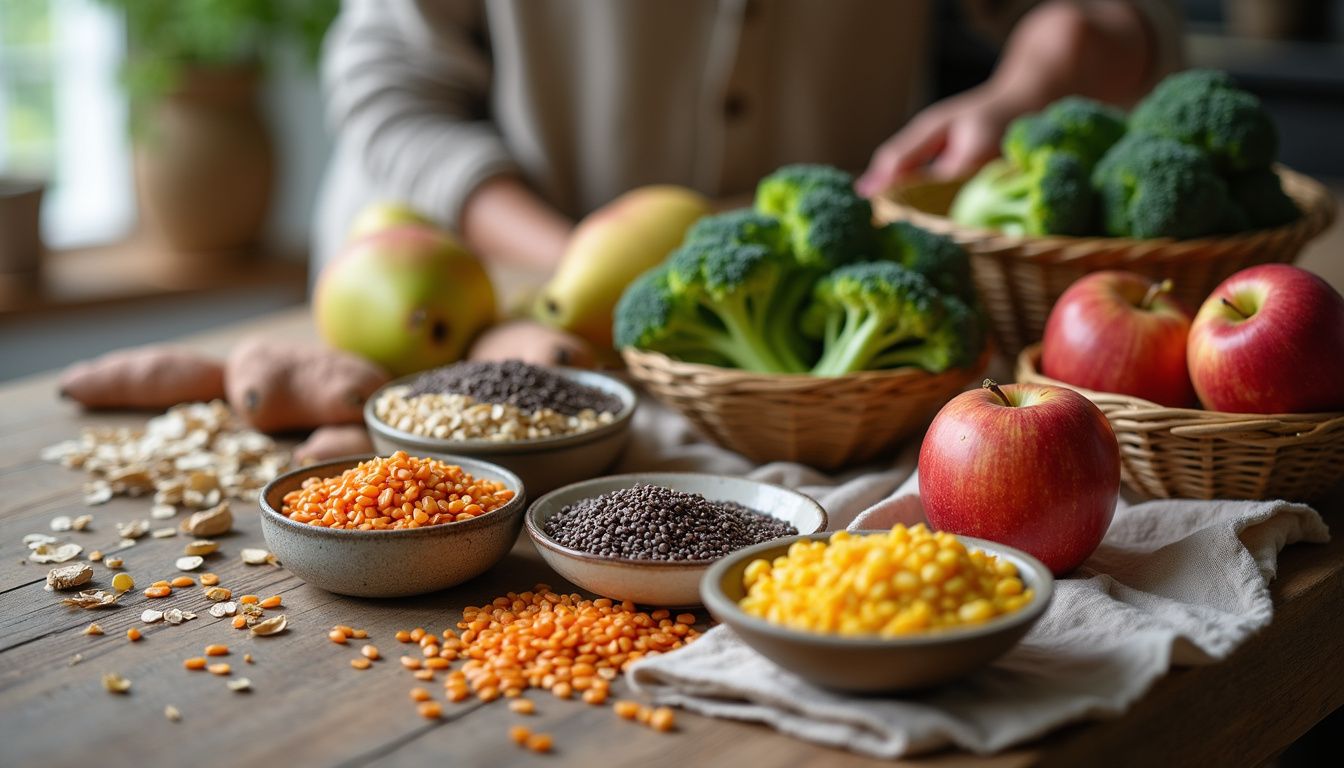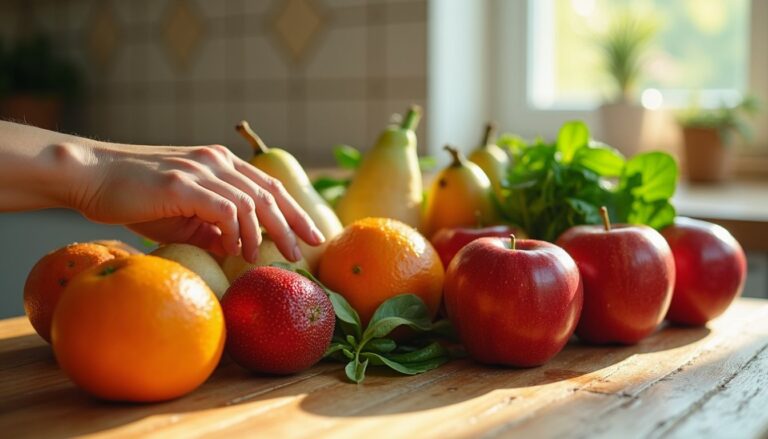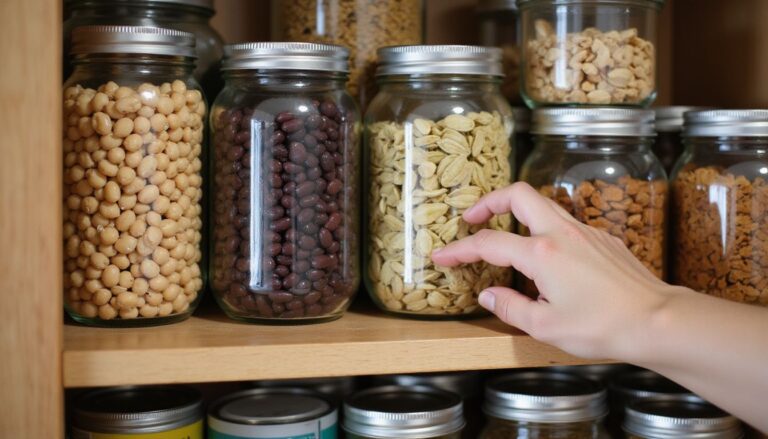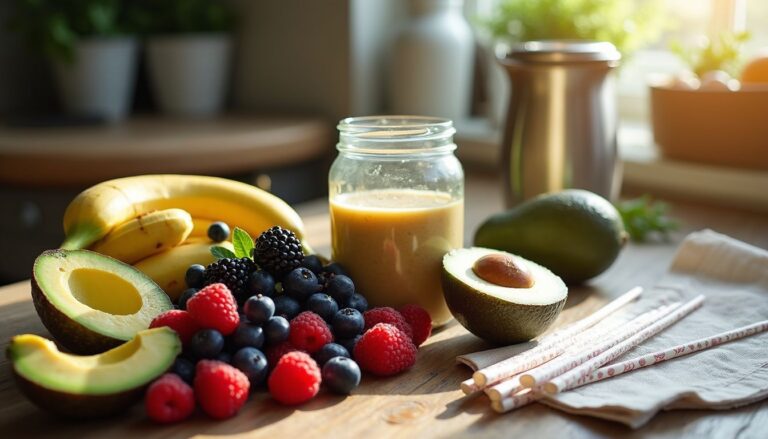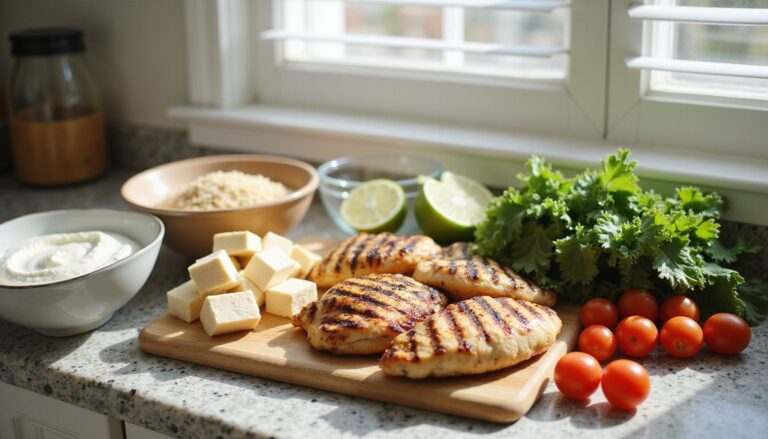Top 6 High-Fiber Foods For Weight Loss: Boost Your Wellness With Fiber-Rich Choices
Our Nutrition Assistant AI Suite will transform your body. You will lose fat, get toned, and build muscle. Gain confidence and optimal health.
Trying to lose weight without feeling hungry all day? High-fiber foods can help by keeping you full, supporting healthy digestion, and protecting your heart. Fiber is the part of plants your body cannot fully break down, and it works hard for your health.
This guide shows how oats, lentils, chia seeds, broccoli, apples, pears, and sweet potatoes fit into a realistic plan. You will see which options are easy to find and how to add them to daily meals and snacks.
Keep reading to find tasty, fiber-rich choices that support weight loss and day-to-day wellness.
Key Takeaways
- Aim for 25 to 38 grams of fiber per day, or about 14 grams per 1,000 calories (Dietary Guidelines for Americans).
- Top high-fiber foods for weight loss include oats (10.4 g per 100 g dry), lentils (15.5 g per cup cooked), chia seeds (10 g per ounce), broccoli (5 g per cup cooked), apples (4.5 g per medium), and sweet potatoes (6.4 g per cup cooked).
- Both soluble fiber, which forms a gel with water, and insoluble fiber, which adds bulk, improve fullness, gut health, and long-term heart and colon health (Academy of Nutrition and Dietetics).
- Increase fiber slowly and drink more water to limit cravings, support regularity, and reduce gas or bloating.
- Choose whole foods rather than fiber powders or pills. Whole foods provide vitamins, minerals, and antioxidants that supplements lack (Mayo Clinic, Cleveland Clinic).
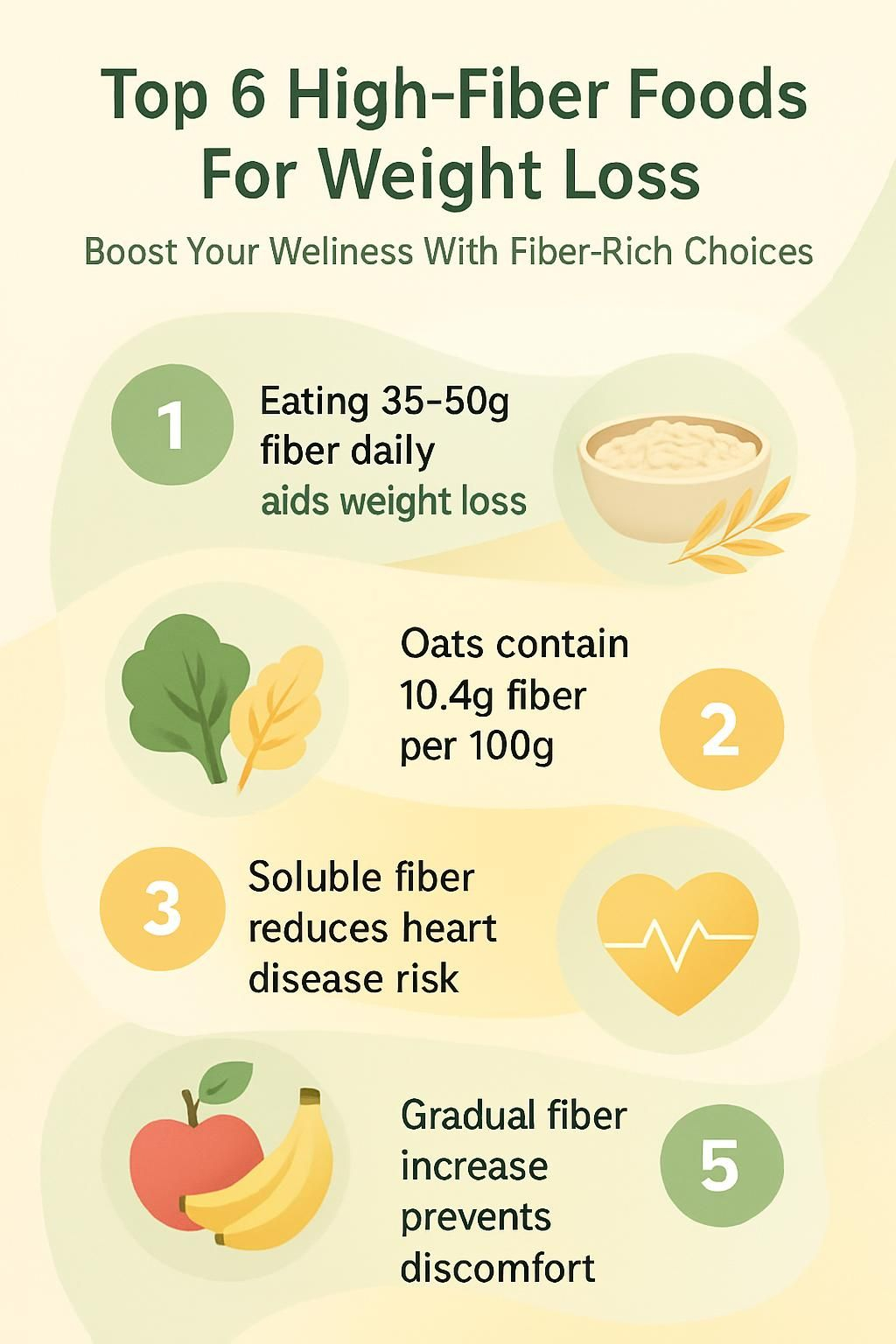
Why Is Fiber Important for Weight Loss and Wellness?

Dietary fiber supports healthy weight management and overall wellness. Foods high in fiber like oats, beans, fruits, and vegetables tend to be lower in calories per bite. They also take longer to chew and digest, which helps you feel satisfied on fewer calories.
There are two main types of fiber. Soluble fiber absorbs water and forms a gel, which slows digestion and helps steady blood sugar. Insoluble fiber adds bulk to stool, which supports regularity and helps manage constipation.
Many people notice less bloating and better bathroom habits within days of eating more whole grains, legumes, and greens. Over time, adequate fiber is linked with a lower risk of heart disease and colon cancer.
High-fiber diets support gut health by feeding beneficial gut bacteria, says registered dietitian Laura Jeffers from Cleveland Clinic.
How Does Fiber Help You Lose Weight?
Fiber makes weight loss feel more manageable. It helps you stay full, smooths out energy swings, and supports a healthy gut.
How Does Fiber Promote Fullness and Reduce Calorie Intake?
High-fiber foods soak up water and add bulk, which slows down how fast your stomach empties. This helps you feel full longer and reduces the urge to snack between meals. Meals that include fiber and protein work especially well for appetite control.
For example, combine 1 cup raspberries, 1 cup cooked oatmeal, and about 12 almonds. You will get roughly 13 to 14 grams of fiber plus satisfying texture and flavor. A bean and veggie salad can add another 10 or more grams.
In my routine, adding broccoli and leafy greens to lunch kept me full through the afternoon. That small shift cut random snacking and supported steady progress.
How Does Fiber Regulate Blood Sugar Levels?
Soluble fiber slows how quickly sugars enter your bloodstream. Oats contain beta glucan, a gel-forming fiber that helps steady blood sugar and can lower LDL cholesterol. Chia seeds offer 10 grams of fiber per ounce and also slow digestion.
Split peas are another strong source. A half cup provides about 8 grams of fiber that can help keep energy stable. Health experts, including Mayo Clinic, note that diets rich in fiber support better metabolic health, especially for those managing diabetes.
If you are switching from white bread to whole-wheat pasta, you may notice more even energy and fewer afternoon dips.
How Does Fiber Support Healthy Digestion and Gut Health?
Fiber feeds the beneficial bacteria in your gastrointestinal tract. These microbes ferment fiber into short-chain fatty acids. Those compounds support the gut lining, help absorb nutrients, and may reduce inflammation.
Eating both soluble and insoluble fiber helps keep bowel movements regular. Soluble fiber softens stool. Insoluble fiber adds bulk, which helps prevent constipation. Staying hydrated allows fiber to move smoothly through your system.
When I increased fiber with lentils, broccoli, and whole grains, digestion felt easier within a week. Less bloating, more energy after meals, and fewer stomach upsets made healthy eating easier to maintain.
Top 6 High-Fiber Foods for Weight Loss
These fiber-rich picks are simple to use and work well in everyday meals.
Oats
Oats are an easy, budget-friendly way to raise fiber intake. One hundred grams of dry rolled oats contains about 10.4 grams of fiber. Oats digest slowly, which helps control hunger and blood sugar.
Beta glucan in oats supports heart health and can help reduce LDL cholesterol. One cup of cooked instant oatmeal has about 4 grams of fiber. A medium oat bran muffin can provide around 5 grams.
Pair oats with fruit like apples or berries for extra fiber and antioxidants. A warm bowl in the morning often keeps cravings away until lunch.
Lentils and Legumes
Legumes are among the highest in fiber. They also supply plant-based protein that supports fullness and muscle health.
- Split peas, 1 cup cooked: about 16 grams of fiber
- Lentils, 1 cup cooked: about 15.5 grams
- Black beans, 1 cup cooked: about 15 grams
- Chickpeas, 1/2 cup cooked: about 6 grams
- Kidney beans, 1/2 cup cooked: about 5 to 6 grams
Adding a serving or two daily, such as lentil soup or a chickpea salad, makes it easier to meet your daily fiber goal. During my own weight loss efforts, split pea soup kept me satisfied for hours without a blood sugar spike.
Chia Seeds
Chia seeds pack a lot of fiber into a tiny serving. One ounce has about 10 grams of fiber. You get both soluble and insoluble types that support digestion and steady blood sugar.
Stir them into yogurt or oatmeal, blend them into smoothies, or make chia pudding. Their mild taste fits into many recipes, which makes daily use simple.
Broccoli
Broccoli is a cruciferous vegetable rich in fiber and vitamins. One cup of cooked broccoli provides about 5 grams of fiber. It is low in calories and works well with many flavors.
Steam, roast, or enjoy it raw. Regular intake supports gut health, and it may help lower heart disease risk. A side of broccoli at lunch is an easy way to raise fiber for the day.
Apples and Pears
These fruits offer a convenient, portable dose of fiber. A medium apple with skin provides about 4.5 grams. A medium pear has about 5.5 grams.
Eat the peel to get the most fiber. Their natural sweetness makes them simple snacks during busy days. Sliced fruit in a lunchbox can curb afternoon hunger with about 100 calories per piece.
Sweet Potatoes
Sweet potatoes supply about 6.4 grams of fiber per cup cooked, plus vitamins and antioxidants. They can be baked, roasted, or mashed.
Their fiber supports fullness and steady energy, which can help reduce snacking. I often add a baked sweet potato at lunch. It keeps me satisfied until dinner.
Which High-Fiber Fruits Should You Eat for Weight Loss?
Fruit adds fiber, hydration, and natural sweetness. These choices fit easily into snacks and meals.
Berries (strawberries, blueberries, blackberries)
Berries are low in calories and high in fiber. One cup of raspberries provides about 8 grams. Blackberries offer about 7 to 8 grams per cup. Strawberries and blueberries provide about 3 to 4 grams per cup.
Stir berries into oatmeal, yogurt, or smoothies for a quick boost. They also deliver antioxidants that support heart health. Adding frozen blueberries to Greek yogurt made my breakfast more filling and steadier.
Avocado
A medium avocado supplies roughly 10 grams of fiber along with healthy fats. The mix supports fullness and steady blood sugar.
Enjoy avocado on toast, in salads, or blended into smoothies for a creamy texture. Because it is calorie dense, use modest portions to keep totals in check.
Bananas
A medium banana provides about 3 grams of fiber. You get both soluble and insoluble types for better regularity.
Bananas make a simple pre-workout snack or smoothie base. Pair half a banana with nut butter for fiber plus protein and fat that lasts.
Which High-Fiber Vegetables Support Weight Loss?
Vegetables add bulk to meals with very few calories. These picks help control hunger and support digestion.
Brussels Sprouts
One cup of cooked Brussels sprouts delivers about 6.4 grams of fiber. They are rich in vitamin C and vitamin K.
Roast, steam, or sauté them for a flavorful side. The fiber supports gut health and may help with cholesterol management. A sheet pan of roasted sprouts often wins over picky eaters with its crispy edges.
Carrots
One medium raw carrot has about 1.5 grams of fiber with only 25 calories. A half cup cooked provides around 2.3 grams.
Snack on carrot sticks, toss them into soups, or roast them as a side. Their fiber helps steady blood sugar and supports regular digestion.
Artichokes
Artichokes are one of the highest-fiber vegetables. One cup cooked offers about 9.6 grams.
They are low in calories and provide helpful antioxidants. Steam, grill, or add artichoke hearts to salads and pasta dishes for an easy fiber lift.
Best High-Fiber Whole Grains to Boost Wellness
Whole grains provide steady energy and meaningful fiber. They also bring minerals and B vitamins that your body needs.
Quinoa
One cup of cooked quinoa provides about 5 grams of fiber along with complete protein. It is also rich in magnesium and folate.
Use it in salads, bowls, or soups. Quinoa cooks quickly and fits many eating patterns, including gluten-free diets.
Barley
Barley offers both soluble and insoluble fiber. One cup of cooked pearled barley provides about 6 grams.
Its nutty flavor works in soups, stews, and grain salads. Barley helps with fullness and supports heart health through better cholesterol control.
Whole-wheat bread and pasta
Whole-wheat options provide more fiber than refined versions. One cup of cooked whole-wheat spaghetti contains about 6 grams of fiber. A slice of whole-wheat bread provides around 2 grams.
Swap white bread and regular pasta for whole-wheat choices to raise daily totals. This simple change supports digestion and steadier blood sugar.
Nuts and Seeds as Fiber-Rich Choices
Nuts and seeds add crunch, flavor, and fiber. They are calorie dense, so measure portions.
Almonds
One ounce of almonds, about 23 nuts, provides roughly 3.5 grams of fiber. They also supply vitamin E and magnesium.
Snack on a small handful, use almond butter, or bake with almond flour. The mix of fiber, fat, and protein supports satiety and better blood sugar control.
Flax Seeds
Flax seeds supply fiber and omega-3 fatty acids, a type of healthy fat. Ground flax is easier to absorb than whole seeds.
Add a spoonful to oatmeal, yogurt, smoothies, or baked goods. Many people notice better regularity within a week of daily use.
Sunflower Seeds
One quarter cup of sunflower kernels provides about 3 grams of fiber plus vitamin E. They are easy to sprinkle on salads, oatmeal, or trail mix.
Because they are calorie dense, keep portions modest. A small handful adds crunch and helps you feel full longer.
How Can You Add More Fiber to Your Diet?
Small changes add up fast. Build fiber into each meal and snack so you hit your daily goal without stress.
Should You Start with Small Changes?
Yes. Begin with one or two swaps a day. Choose oats instead of sugary cereal, or grab an apple instead of a pastry.
Try a small serving of lentils and increase the portion over time. Drink more water as you add fiber. Track what works for your body and adjust as needed.
Why Combine High-Fiber Foods with Healthy Fats and Proteins?
Fiber, fat, and protein work together to keep you satisfied. Avocado offers fiber and healthy fat in one food. Almonds add fiber and fat that slow digestion.
Spread nut butter on fruit, or blend chia seeds with yogurt and berries. This balance helps prevent blood sugar spikes and crashes, which can drive cravings.
How Much Water Should You Drink?
Aim for at least 8 cups, or 64 ounces, daily. Fiber pulls in water, so extra fluids help prevent constipation.
Choose water, sparkling water, or unsweetened tea. If you exercise, live in hot weather, or increase fiber quickly, you may need more.
How to Add Fiber to Every Meal or Snack?
Once hydration is in place, build fiber into your routine with simple steps.
- Top breakfast cereal or yogurt with berries or sliced apples or pears. Berries provide 3 to 8 grams per cup. Apples and pears offer about 4 to 6 grams each.
- Stir chia seeds or ground flax into oatmeal, smoothies, or batter. Chia has about 10 grams per ounce.
- Use whole-wheat bread for sandwiches or toast. Each slice adds about 2 to 3 grams.
- Add leafy greens or broccoli to salads, soups, or dinner plates. One cup of cooked broccoli has about 5 grams.
- Include beans or lentils in salads, stews, or wraps. One cup of cooked lentils provides roughly 15 grams.
- Choose air-popped popcorn for a snack. Three cups provide about 4 grams with far fewer calories than chips.
- Snack on almonds, sunflower seeds, or raw vegetables. A quarter cup of almonds supplies about 4 grams.
- Serve roasted sweet potatoes or carrots as sides. One medium sweet potato has around 4 grams.
- Pair fiber with protein and healthy fat. Try hummus with raw veggies for longer-lasting fullness.
- Start small. Adding fruit at breakfast made it easier for me to enjoy more fiber all day.
What Challenges Can You Face on a High-Fiber Diet?
Raising fiber can bring short-term bloating, gas, or changes in bathroom habits. A gradual approach helps your body adapt.
How to Adjust to a Higher Fiber Intake?
Increase fiber slowly over one to three weeks. Add small portions of oats, lentils, or vegetables, then build up.
Drink extra water to help fiber move through your gut. Track how you feel and slow down if you notice discomfort. If symptoms persist, talk with a registered dietitian or your healthcare provider.
Why Avoid Processed Fiber Supplements?
Powders and pills often lack the full benefits of whole foods. Whole foods bring fiber plus vitamins, minerals, antioxidants, and texture that supports fullness.
Supplements may cause gas or bloating, and they do not always improve satiety. Focus on fruits, vegetables, whole grains, nuts, and seeds to get balanced nutrition and lasting benefits.
Conclusion
High-fiber foods make weight loss more sustainable. Oats, lentils, chia seeds, broccoli, apples, pears, and sweet potatoes help you feel full, steady blood sugar, and support a healthy gut.
Raise your fiber intake gradually, drink plenty of water, and build fiber into each meal. Whole foods work better than supplements for most people. If you have digestive conditions or take certain medicines, check with your clinician or a dietitian first.
With steady habits and fiber-rich choices, you can support weight management and daily wellness, one meal at a time.
FAQs
1. What are the top six high-fiber foods that support weight loss and overall health?
Whole grains, lentils, black beans, raspberries, broccoli, and chia seeds are among the top high-fiber foods. Each offers a significant amount of dietary fiber, which supports weight loss and promotes overall health.
2. How does fiber help with weight loss and overall health?
Fiber slows digestion, which helps you feel full longer. This can reduce calorie intake and support weight loss. Fiber also supports digestive health and helps regulate blood sugar, both important for overall health.
3. How much fiber should I eat daily for weight loss and overall health?
Most adults should aim for at least 25 to 30 grams of fiber each day from food sources. Eating a variety of high-fiber foods helps meet this goal and supports both weight loss and overall health.
4. Can you share a personal experience with high-fiber foods and their effect on overall health?
After adding more lentils and whole grains to my meals, I noticed improved digestion and felt full for longer periods. This change made it easier to manage my weight and improved my overall health, as supported by research on fiber-rich diets.

